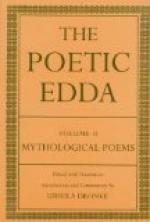The latest edition of the Gudrun is by Ernst Martin (second edition, Halle, 1902). There is a modern German translation by Simrock.
Angantyr. (Page 42.)
The poems of this cycle are four in number—(1) Hjalmar’s Death-song: (2) Angantyr and Hervoer; (3) Heidrek’s Riddle-Poem: (4) Angantyr the Younger and Hlod. All are given in the first volume of the Corpus, with translations.
Herrarar Saga was published by Rafn (Copenhagen, 1829-30) in Fornaldar Soegur, vol. i., now out of print. It has been more recently edited by Dr. Bugge, together with Voelsunga and others. Petersen (Copenhagen, 1847) edited it with a Danish translation. Munch’s Nordmuendenes Gudelaere (out of print) contains a short abstract.
Death of Angantyr. (Page 43.)
Angantyr’s death is related by Saxo, Book v., with entire exclusion of all mythical interest.
Transmission of Legends. (Page 47.)
Muellenhoff’s views are given in the Zeitschrift fuer deutsches Altertum, vol. x.; Maurer’s in the Zeitschrift fuer deutsche Philologie, vol. ii. For Golther’s views on the Volsung cycle see Germania, 33.
The Dragon Myth. (Page 49.)
See also Hartland, Science of Fairy-Tales.
The eating of the dragon’s heart (see p. 19) may possibly be a survival of the custom of eating a slain enemy’s heart to obtain courage, of which Dr. Frazer gives examples in the Golden Bough.
Alien Wives. (Page 49.)
For the theory of alien wives as a means of transmission, see Lang, Custom and Myth (London, 1893).
The Sister’s Son. (Page 51.)
See Mr. Gummere’s article in the English Miscellany; and Professor Rhys’ Presidential Address to the Anthropological Section of the British Association, 1900. The double relationship between Sigmund and Sinfjoetli (not uncommon in heroic tales; compare Conchobhar and Cuchulainn, Arthur and Mordred) seems in this case due to the same cause as the custom which prevailed in the dynasty of the Ptolemies, where the king often married his sister, that his heir might be of the pure royal blood.
Swanmaids. (Page 51.)
See Hartland, Science of Fairy-Tales.
The Waverlowe. (Page 51.)
Dr. Frazer (Golden Bough) gives instances of ritual marriages connected with the midsummer fires. For Svipdag and Menglad, see Study No. 12 of this series. If Rydberg, as seems very probable, is right in identifying Menglad and Svipdag with Freyja and the mortal lover who wins her and whom she afterwards loses, the story would be a parallel to those of Venus and Adonis, Ishtar and Tammuz, &c., which Frazer derives from the ritual marriage of human sacrifices to the Goddess of fertility. The reason given in the Edda for Brynhild’s sleep, and her connexion with Odin, are secondary, arising from the Valhalla myth.




